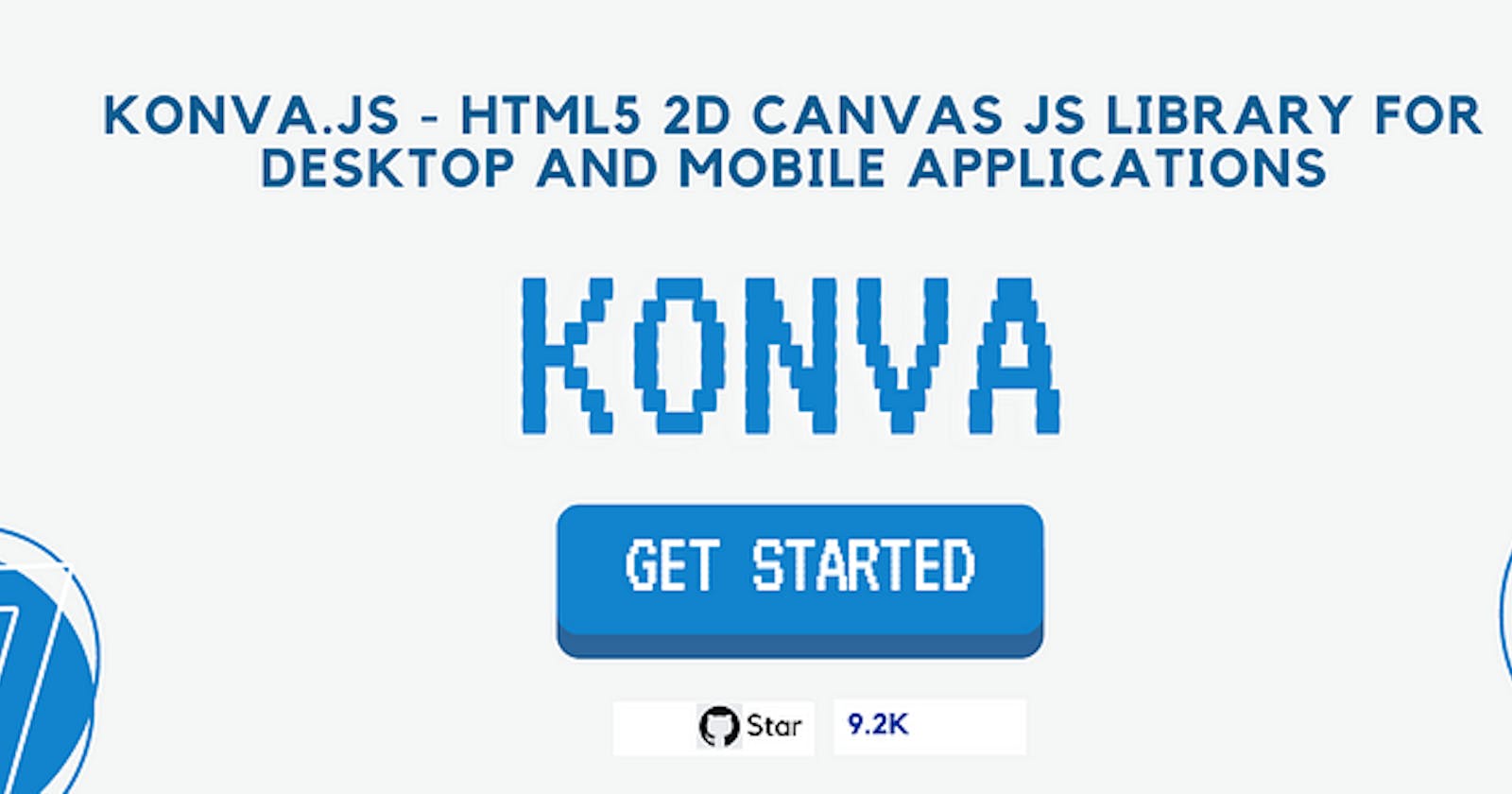Are you looking to get started with Konva.js? You have come to the right place.
Konva for beginners
Introduction Konva is a 2D JavaScript drawing library for creating interactive graphics and animations on the web. It’s built on top of the HTML5 canvas element and provides a simple and powerful API for creating complex shapes, animations, and interactions.
HTML canvas is an HTML element that provides a space for drawing graphics and animations on a web page using JavaScript.It is widely used for creating interactive graphics and animations on the web. It provides a powerful platform for creating custom visualizations, games, data visualizations, and more.
The Basics
The library provides a set of components that can be used to create complex shapes and animations. Some of the most commonly used components include:
- Stage: This is the top-level component that provides the drawing area and handles all the rendering. It has a fixed width and height and can contain multiple layers.
- Layer: This is a container for shapes that allows them to be grouped and manipulated as a single unit. Each layer can have its own set of properties, such as opacity and blending mode.
- Shape: This is a base class for all the drawing primitives, such as Rect, Circle, and Text. It provides a set of common properties and methods that can be used to manipulate the shapes.
- Group: This is a container for multiple shapes that allows them to be manipulated as a single unit. It can also have its own set of properties, such as position and rotation.
- Transformer: This is a component that allows the user to interactively transform a shape by dragging its handles. It can be attached to a shape or a group using the ref prop.
Konva also provides a set of utility functions and methods for manipulating shapes and animations, such as tweening and easing functions and other powerful sets of tools for creating complex graphics and animations in the browser.
Difference between Konva.js and React Konva Konva.js and React Konva are two related but distinct libraries for creating interactive graphics and animations on the web. Konva.js is a standalone (ie. not tied to any particular library) library that provides a simple and powerful API for creating complex shapes, animations, and interactions on the HTML5 canvas element while React Konva is a React wrapper around Konva.js that provides a higher-level abstraction layer, making it easier to use Konva.js within a React application. It provides a set of React components that wrap the Konva.js shapes and animations, allowing them to be used as regular React components. This can make it easier to build complex applications with React, as React Konva integrates seamlessly with the React component architecture.
However, using React Konva does come with some performance overhead, as it requires the use of React’s virtual DOM and lifecycle methods. If performance is a major concern, using Konva.js directly may be a better option.
Why use Konva? Konva has several advantages that make it a popular choice for creating interactive graphics and animations on the web:
- High Performance: Konva is built on top of the HTML5 canvas element, which provides high performance for rendering graphics on the web. Konva uses hardware acceleration and optimized rendering techniques to ensure smooth animations and interactions even with large numbers of shapes.
- Easy to Use: Konva has a simple and intuitive API that makes it easy to create and manipulate shapes, animations, and interactions. The API is well-documented and easy to learn, even for beginners.
- Cross-platform Compatibility: Konva works seamlessly across all modern desktop and mobile browsers, providing a better user experience for their audience and making it easier for developers.
- Rich Set of Features: Konva provides a rich set of features for creating complex graphics and animations, including support for shapes, images, text, gradients, filters, and more. It also provides a range of built-in animation and tweening functions to make it easy to create smooth animations.
- Community Support and Well Documentation: Konva has a large and active community of developers who contribute to the library, create plugins and extensions, and provide support. The project itself is very well documented and written about by admirers like myself.
Prerequisites
In order to effectively use Konva to its full potential, one should also have knowledge of the following concepts:
- Good understanding of HTML, CSS, and JavaScript, as Konva is a JavaScript library that works with the HTML5 canvas element.
- Graphics and Animation: Konva is primarily used for creating graphics and animations on the web, so a good understanding of these concepts is essential.
- Object-oriented Programming: Konva uses an object-oriented programming paradigm to create and manipulate shapes, animations, and interactions. Therefore, a good understanding of OOP concepts like classes, objects, and inheritance is important.
- DOM manipulation: Although Konva is built on top of the canvas element, it still requires some level of DOM manipulation to create and manage the canvas element, add event listeners, and handle user interactions.
- Browser compatibility: Konva works across all modern desktop and mobile browsers, but you should have a good understanding of browser compatibility issues and how to test your code on different browsers.
Other cool things you can do with Konva It’s an easy-to-use and versatile library that simplifies otherwise complex and tedious tasks with its powerful, flexible, and intuitive APIs such as:
- Real-world physics simulations
- Collision Detection
- Modify Curves with Anchor points to create a custom shape
- Web Worker: Utilize the power of web workers to offload heavy processing tasks and improve performance.
- Add touch gestures for mobile and tablet devices.
And many more.
Learn More Check out a few of the following cool projects that use Konva:
If you are hyped and want to explore it further, find it here.
Konva Docs : https://konvajs.org/docs/index.html
